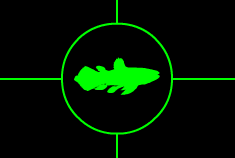
Coelacanth
Other Names: None
Scientific Name: Latimeria chalumnae
Size Range: About 5 feet
Habitat: Indian Ocean near southern Africa
Depth Range: 600 - 1,000 feet
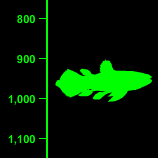
Coelacanth
(Latimeria chalumnae)
The strange-looking coelacanth is one of the oldest species of fish in the world. It is considered by many to be an actual living fossil. Known scientifically as Latimeria chalumnae, this fish was thought to have been extinct since the end of the cretaceous period over 65 million years ago. Fossils of the coelacanth have been found that date back over 350 million years. But, against all odds, in 1938, a fisherman actually caught a live coelacanth off the coast of South Africa. A second specimen was captured in 1952 off the coast of the Comoros Islands off the eastern coast of Africa near Madagascar. Needless to say, this caused a sensation throughout the scientific community. Since then, live coelacanths have been sighted and photographed many times in the wild.
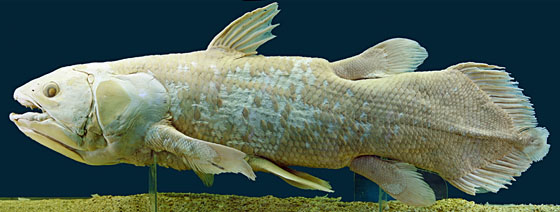
Preserved Coelacanth specimen on display at the natural history museum in
Vienna, Austria (© Alberto Fernandez Fernandez CC BY-SA 3.0)
The coelacanth is closely related to the lungfishes and tetrapods, ancient animals that form part of the evolutionary bridge between sea creatures and land dwellers. The long fins of the coelacanth actually contain bones that resemble toes divided into three lobes. Because of this, it is referred to as a lobe-finned fish. These leg-like fins have earned this fish the nickname, "old fourlegs". Another prehistoric feature of this unique fish are its scales. These highly modified scales are known as cosmoid scales, and are only found on extinct fish species. They are woven tight like armor and are rough to the touch. These hard scales help protect the fish from rocks and predators. Coelacanths are large fish, growing to average length of 6.5 feet (2 meters). They can weigh as much as 175 pounds (80 kg). In the wild, they have a deep blue color which is thought to help camouflage them from predators. The eyes of the coelacanth are extremely sensitive to light. They contain a special adaptation known as a tapetum, which is also found in cats, dogs, and dolphins. It is the tapetum that causes a cat's eyes to glow when exposed to bright light. This highly specialized eye enables the coelacanth to see as much as possible in the lightless environments of the deep sea.
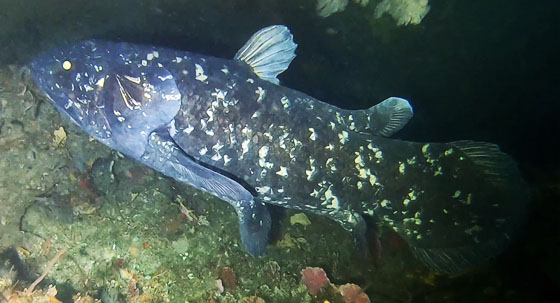
Live coelacanth photographed off Pumula on the KwaZulu-Natal South Coast,
South Africa (© Bruce A.S.Henderson CC BY-SA 4.0)
Ceolacanths are opportunistic feeders, eating just about anything they can find and fit in their mouth. They possess hinges in their skulls that allow them to consume very large prey. Their diet is believed to consist mainly of squid, eels, small sharks, and other animals that are found in their deep sea habitats. They hunt their prey near deep underwater volcanic slopes and can frequently be seen swimming with their heads down. They have even been seen swimming upside down and backwards. Researchers believe that this behavior allows them to use a special organ called a rostral gland to help them locate their prey. Once located, their meal is usually swallowed whole. Since food can be scarce at these great depths, scientists believe that the coelacanth has the ability to slow down its metabolism. This allows the fish to go for long periods of time without eating. This may be part of the reason they have survived so long and outlived their other prehistoric cousins. In their natural habitat, they are believed to live about 60 years.
Coelacanths give birth to live young, known as "pups". There are usually between 5 and 25 pups born at any given time. These young coelacanth pups are fully formed and capable of surviving on their own as soon as they are born. Their gestation time is 13 months, and it is believed that ceolacanths are unable to reproduce until they are 20 years old. Beyond that, very little is known about the reproductive habits of this elusive creature.
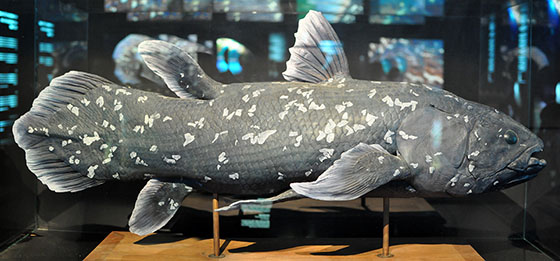
Museum Replica of a West Indian Ocean coelacanth
(© Citron / CC BY-SA 3.0)
Coelacanths can be found throughout the Indian ocean, from the southwest coast of Africa to Indonesia. They can to go as deep as 2,300 feet (700 meters), but are more commonly found at a depth of 300 - 600 feet (90 - 200 meters). Because of their sensitive eyes, these fish prefer the darkness. They are rarely ever seen during the daytime hours or on nights with a full moon. They prefer cold water because their gills have trouble absorbing oxygen in warm water. In Sodwana Bay, South Africa, coelacanths have been found resting in caves during the day.
In 1989, the coelacanth was declared an endangered species by the international community. Their current world population is believed to be fewer than 500 animals. This means that without protection, this prehistoric animal that has survived for over 350 million years could be wiped out in our lifetime.
Deep Sea
Creature Database
'



